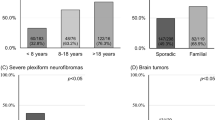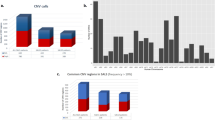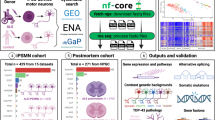Abstract
Spinal neurofibromatosis (SNF) is a form of neurofibromatosis type 1 (NF1) characterized by bilateral neurofibromas involving all spinal roots. The pathogenic mechanisms determining the SNF form are currently unknown. To verify the presence of genetic variants possibly related to SNF or classic NF1, we studied 106 sporadic NF1 and 75 SNF patients using an NGS panel of 286 genes encoding RAS pathway effectors and neurofibromin interactors and evaluated the expression of syndecans (SDC1, SDC2, SDC3, SDC4), the NF1 3’ tertile interactors, by quantitative real-time PCR. We previously identified 75 and 106 NF1 variants in SNF and NF1 cohorts, respectively. The analysis of the distribution of pathogenic NF1 variants in the three NF1 tertiles showed a significantly higher prevalence of NF1 3’ tertile mutations in SNF than in the NF1 cohort. We hypothesized a potential pathogenic significance of the 3’ tertile NF1 variants in SNF. The analysis of syndecan expression on PBMCs RNAs from 16 SNF, 16 classic NF1 patients and 16 healthy controls showed that the expression levels of SDC2 and SDC3 were higher in SNF and NF1 patients than in controls; moreover, SDC2, SDC3 and SDC4 were significantly over expressed in patients mutated in the 3’ tertile compared to controls. Two different mutational NF1 spectra seem to characterize SNF and classic NF1, suggesting a pathogenic role of NF1 3’ tertile and its interactors, syndecans, in SNF. Our study, providing new insights on a possible role of neurofibromin C-terminal in SNF, could address effective personalized patient management and treatments.
This is a preview of subscription content, access via your institution
Access options
Subscribe to this journal
Receive 12 print issues and online access
$259.00 per year
only $21.58 per issue
Buy this article
- Purchase on Springer Link
- Instant access to full article PDF
Prices may be subject to local taxes which are calculated during checkout



Similar content being viewed by others
Data availability
The raw reads of panel NGStr3 are available in NCBI Short-read Archive (SRA, https://www.ncbi.nlm.nih.gov/sra) under the accession number PRJNA8509016 and the raw reads of panel NGStr2 under the accession number PRJNA688415.
References
Kang E, Kim YM, Seo GH, Oh A, Yoon HM, Ra YS, et al. Phenotype categorization of neurofibromatosis type I and correlation to NF1 mutation types. J Hum Genet. 2020;65:79–89.
Ruggieri M, Polizzi A, Spalice A, Salpietro V, Caltabiano R, D’Orazi V, et al. The natural history of spinal neurofibromatosis: a critical review of clinical and genetic features. Clin Genet. 2015;87:401–10.
Nguyen R, Dombi E, Akshintala S, Baldwin A, Widemann BC. Characterization of spinal findings in children and adults with neurofibromatosis type 1 enrolled in a natural history study using magnetic resonance imaging. J Neurooncol. 2015;121:209–15.
Sharif S, Upadhyaya M, Ferner R, Majounie E, Shenton A, Baser M, et al. A molecular analysis of individuals with neurofibromatosis type 1 (NF1) and optic pathway gliomas (OPGs), and an assessment of genotype-phenotype correlations. J Med Genet. 2011;48:256–60.
Bergoug M, Doudeau M, Godin F, Mosrin C, Vallée B, Bénédetti H. Neurofibromin structure, functions and regulation. Cells. 2020;9:2365.
Ratner N, Miller SJ. A RASopathy gene commonly mutated in cancer: the neurofibromatosis type 1 tumour suppressor. Nat Rev Cancer. 2015;15:290–301.
Sherekar M, Han S-W, Ghirlando R, Drew M, Rabara D, Waybright T, et al. Biochemical and structural analyses reveal that the tumor suppressor neurofibromin (NF1) forms a high-affinity dimer. J Biol Chem. 2020;295:1105–19.
Young LC, Goldstein de Salazar R, Han S-W, Huang ZYS, Merk A, Drew M, et al. Destabilizing NF1 variants act in a dominant negative manner through neurofibromin dimerization. Proc Natl Acad Sci USA. 2023;120:e2208960120.
Melloni G, Eoli M, Cesaretti C, Bianchessi D, Ibba MC, Esposito S, et al. Risk of optic pathway glioma in neurofibromatosis type 1: no evidence of genotype-phenotype correlations in a large independent cohort. Cancers. 2019;11:1838.
Wang W, Wei C-J, Cui X-W, Li YH, Gu YH, Gu B, et al. Impacts of NF1 gene mutations and genetic modifiers in neurofibromatosis type 1. Front Neurol. 2021;12:704639.
Mußotter T, Kluwe L, Högel J, Nguyen R, Cooper DN, Mautner VF, et al. Non-coding RNA ANRIL and the number of plexiform neurofibromas in patients with NF1 microdeletions. BMC Med Genet. 2012;13:98.
Tritto V, Ferrari L, Esposito S, Zuccotti P, Bianchessi D, Natacci F, et al. Non-coding RNA and tumor development in neurofibromatosis type 1: ANRIL Rs2151280 is associated with optic glioma development and a mild phenotype in neurofibromatosis type 1 patients. Genes. 2019;10:892.
Paterra R, Bettinaglio P, Borghi A, Mangano E, Tritto V, Cesaretti C, et al. A translational approach to spinal neurofibromatosis: clinical and molecular insights from a wide Italian cohort. Cancers. 2022;15:59.
Ferrari L, Mangano E, Bonati MT, Monterosso I, Capitanio D, Chiappori F, et al. Digenic inheritance of subclinical variants in Noonan Syndrome patients: an alternative pathogenic model? Eur J Hum Genet. 2020;28:1432–45.
Wang K, Li M, Hakonarson H. ANNOVAR: functional annotation of genetic variants from high-throughput sequencing data. Nucleic Acids Res. 2010;38:e164.
Auton A, Brooks LD, Durbin RM, Garrison EP, Kang HM, Korbel JO, et al. A global reference for human genetic variation. Nature. 2015;526:68–74.
Firth HV, Richards SM, Bevan AP, Clayton S, Corpas M, Rajan D, et al. DECIPHER: database of chromosomal imbalance and phenotype in humans using ensembl resources. Am J Hum Genet. 2009;84:524–33.
Landrum MJ, Lee JM, Benson M, Brown GR, Chao C, Chitipiralla S, et al. ClinVar: improving access to variant interpretations and supporting evidence. Nucleic Acids Res. 2018;46:D1062–7.
Richards S, Aziz N, Bale S, Bick D, Das S, Gastier-Foster J, et al. Standards and guidelines for the interpretation of sequence variants: a joint consensus recommendation of the American College of Medical Genetics and Genomics and the Association for Molecular Pathology. Genet Med J Am Coll Med Genet. 2015;17:405–24.
Hamosh A, Scott AF, Amberger JS, Bocchini CA, McKusick VA. Online Mendelian Inheritance in Man (OMIM), a knowledgebase of human genes and genetic disorders. Nucleic Acids Res. 2005;33:D514–7.
Tate JG, Bamford S, Jubb HC, Sondka Z, Beare DM, Bindal N, et al. COSMIC: the catalogue of somatic mutations in cancer. Nucleic Acids Res. 2019;47:D941–7.
Lupton CJ, Bayly-Jones C, D’Andrea L, Huang C, Schittenhelm RB, Venugopal H, et al. The cryo-EM structure of the human neurofibromin dimer reveals the molecular basis for neurofibromatosis type 1. Nat Struct Mol Biol. 2021;28:982–8.
Naschberger A, Baradaran R, Rupp B, Carroni M. The structure of neurofibromin isoform 2 reveals different functional states. Nature. 2021;599:315–9.
Frayling IM, Mautner V-F, van Minkelen R, Kallionpaa RA, Aktaş S, Baralle D, et al. Breast cancer risk in neurofibromatosis type 1 is a function of the type of NF1 gene mutation: a new genotype-phenotype correlation. J Med Genet. 2019;56:209–19.
Hu H-T, Shih P-Y, Shih Y-T, Hsueh Y-P. The involvement of neuron-specific factors in dendritic spinogenesis: molecular regulation and association with neurological disorders. Neural Plast. 2016;2016:5136286.
Malavaki CJ, Roussidis AE, Gialeli C, Kletsas D, Tsegenidis T, Theocharis AD, et al. Imatinib as a key inhibitor of the platelet-derived growth factor receptor mediated expression of cell surface heparan sulfate proteoglycans and functional properties of breast cancer cells. FEBS J. 2013;280:2477–89.
Acknowledgements
The authors are grateful to patients for their cooperation and support. The authors thank Simona Curti for English language revision. This research is supported (not financially) by the European Reference Network on Genetic Tumour Risk Syndromes (ERN GENTURIS). The authors ME, VS, CC and FN are members of ERN GENTURIS. ERN GENTURIS is funded by the European Union.
Funding
This research was funded by the Italian Ministry of Health, grant number RF-2016-02361293 (to PR, ME, FN), by ANF ODV (to PR), and by University of Campania “Luigi Vanvitelli”—project V:ALERE 2019 Id343-TRANSITION “Nutri-epigenetics and physical activity: a natural help for Neurofibromatosis type 1” (to MABM).
Author information
Authors and Affiliations
Contributions
Conceptualization: PR, ME, and PB; methodology: PB, VT, RB, RP, AB, and EM; software: EM; validation: VT, PB, EM, CC, and MABM; investigation: PB, EM, and PR; resources: ME, PR, and FN; data curation: FN, PB, and ME; writing—original draft preparation: PR, PB, and EM; writing—review and editing: PR and PB; supervision: PR, ME, and FN; project administration: PR; funding acquisition: ME, PR, FN, and MABM. All authors have read and agreed to the published version of the manuscript.
Corresponding authors
Ethics declarations
Competing interests
The authors declare no competing interests.
Ethical approval
The study was conducted according to the guidelines of the Declaration of Helsinki and approved by the Fondazione IRCCS Istituto Neurologico Carlo Besta Ethical Committee and Scientific Board (N°50-19/3/2018).
Informed consent
Informed consent was obtained from all subjects involved in the study.
Additional information
Publisher’s note Springer Nature remains neutral with regard to jurisdictional claims in published maps and institutional affiliations.
Supplementary information
Rights and permissions
Springer Nature or its licensor (e.g. a society or other partner) holds exclusive rights to this article under a publishing agreement with the author(s) or other rightsholder(s); author self-archiving of the accepted manuscript version of this article is solely governed by the terms of such publishing agreement and applicable law.
About this article
Cite this article
Bettinaglio, P., Mangano, E., Tritto, V. et al. New insights into the molecular basis of spinal neurofibromatosis type 1. Eur J Hum Genet 31, 931–938 (2023). https://doi.org/10.1038/s41431-023-01377-x
Received:
Revised:
Accepted:
Published:
Issue Date:
DOI: https://doi.org/10.1038/s41431-023-01377-x
This article is cited by
-
A new impact factor for EJHG in 2022
European Journal of Human Genetics (2023)



